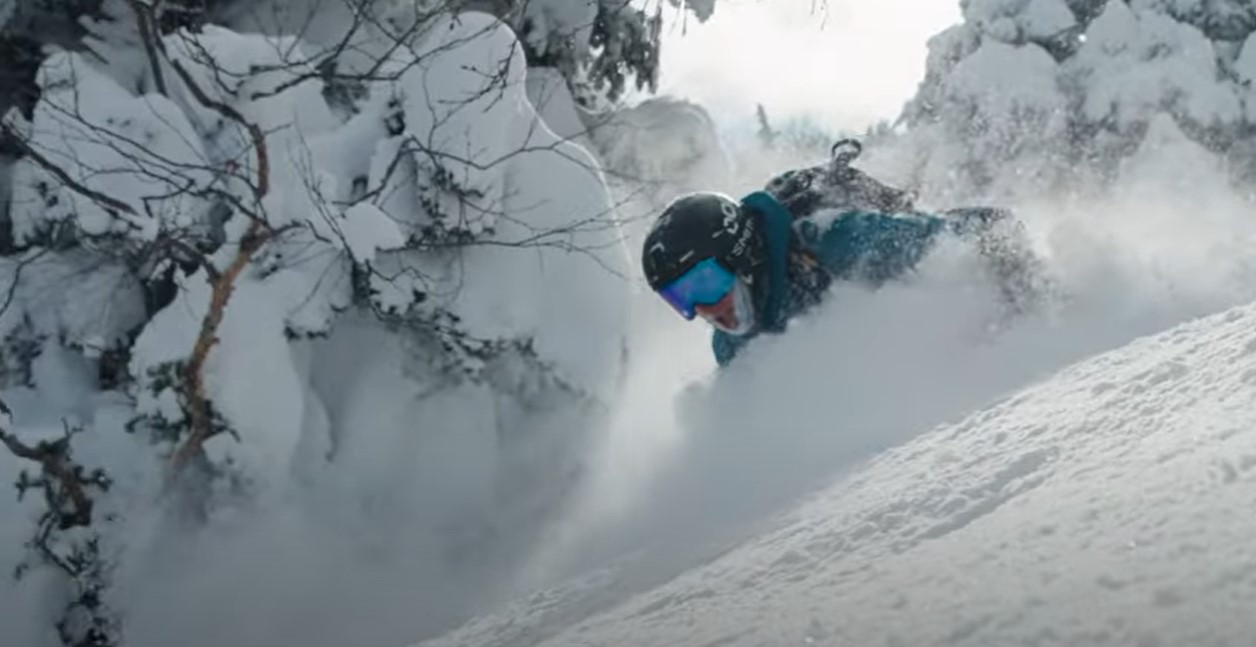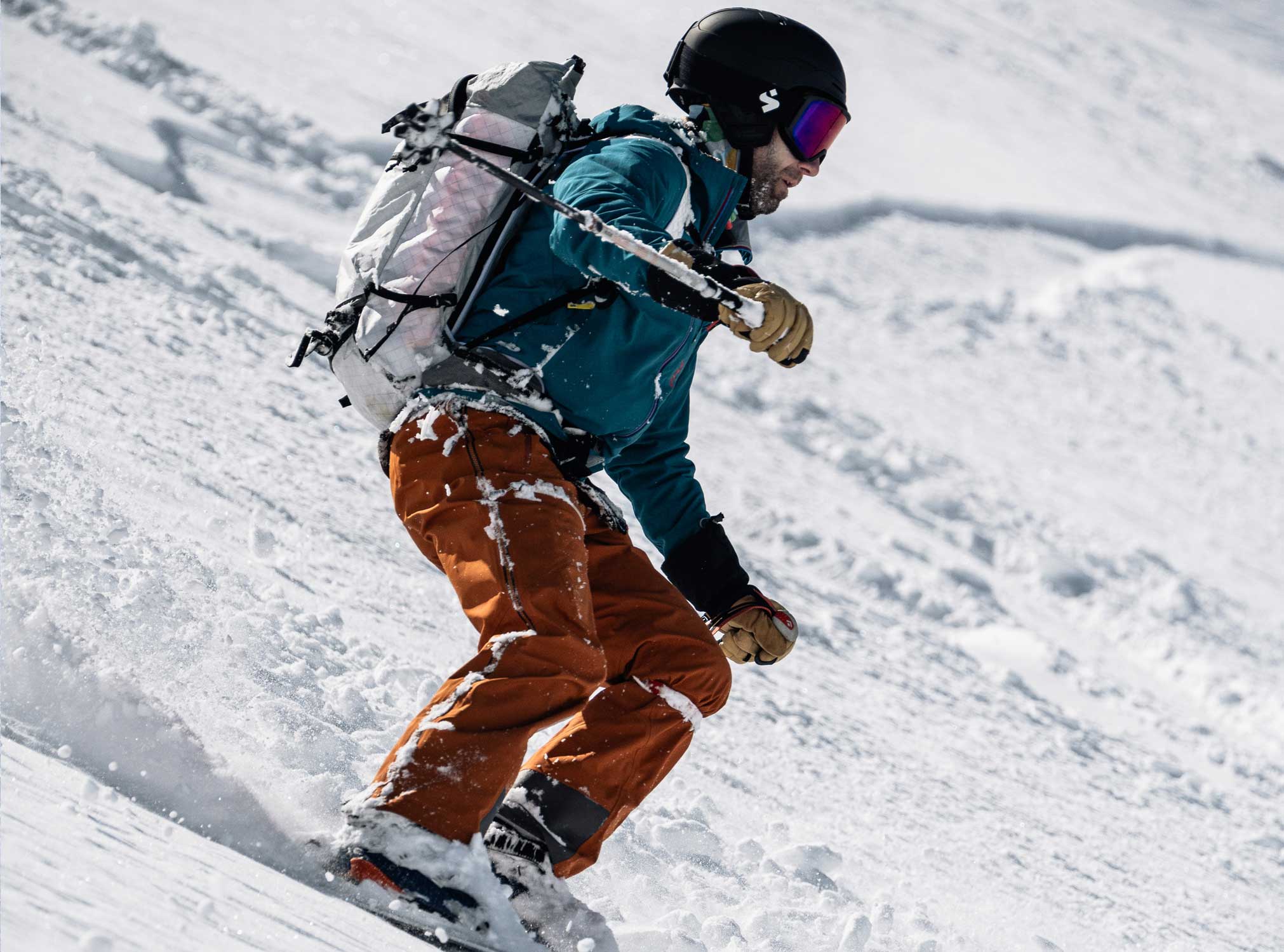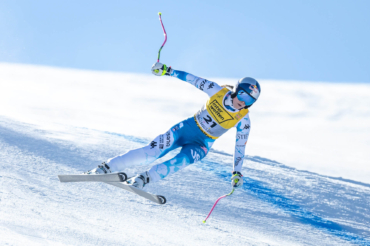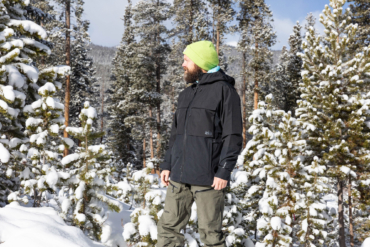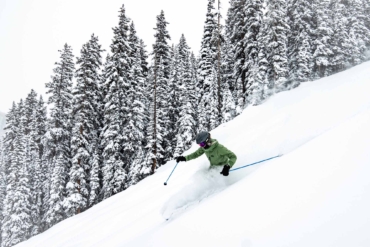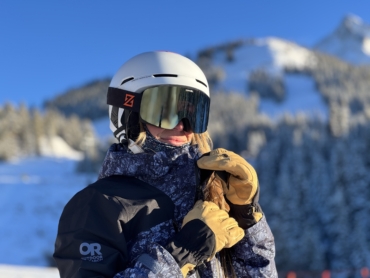Kneeling in the snow, I squint into the pelting wind and deafening hum of the chopper before it drifts upward and away. The scene opens to sprawling, untouched powder and surrounding rocky peaks. I feel a rush of exhilaration and a deep sense of remoteness.
No alpine tour will take you to such far-flung, high-elevation Canadian slopes as those reached by helicopter. I’d dreamt about being dropped like this, out onto remote peaks to drift through thigh-deep powder, for decades. And last winter, after discovering that RK Heliski in British Colombia offers one-day trips, it finally happened.
Located adjacent to Panorama Resort, RK Heliski is one of Canada’s longest-running heli-outfitters. Originally called Radium Springs Glacier Skiing, it was founded by Roger Keith Madson (hence the “RK”) in 1970 and has been situated at its current location since 1988.
Here’s how my trip came together, what I packed, what you need to know, and what I’ll do differently the next time I go.
A One-Day Heli-Trip in British Columbia

Getting There
My spouse and I made the trip to Canada in early March. Flying directly from Denver into Calgary, Alberta, the nearest major international airport. From Calgary it’s about a 3.5-hour drive to Panorama, British Columbia, then another hour and a half to Golden, British Columbia.
Rider Express offers two options for bus tickets from Calgary to Golden, both for between $65-75. That’s cheaper than renting a car, but makes it harder to get around once you get there.
First, we tested our legs (and courage) on the knee-knocking steep terrain of the Kicking Horse Mountain Resort. That mountain’s gondola takes you 4,000 vertical feet to the summit, where 85 chutes plummet downward (some of them require hiking with the use of ropes and rails). Kicking Horse easily earned the status of steepest resort I’d ever skied.
Afterward, we took a couple of days exploring Panorama Resort, which had great inbounds and side country. But I wanted to get way out of bounds. This was how I found RK Heliski, a local helicopter ski guide company and the highest operation of its kind in North America. They offer three- and five-run day excursions with groups of 10, and private days for groups of four to nine people.
I was intrigued. So I signed up solo for a one-day, three-run heli-ski trip with RK Heliski.
RK Heliski
My three-run day with RK Heliski cost $736 during the high season (Jan. 16 to March 31). The five-run days run for $856 per person, and the five-run private day is $5,700 for the whole group.
That’s on the pricier side for helicopter skiing. Mike Weigele Helicopter Skiing in Blue River, British Columbia, sells 3-day packages for groups of 10 for $5,715 during high season — which shakes out to about $190 per person. Last Frontier Helicopter Skiing in Ripley Creek, British Columbia, offers 4-day packages for groups of 10 for $6,996 during high season — about $175 per person.
However, those other operators don’t offer single-day trips. That’s where RK Heliski was unique. I didn’t have to set aside a multiday chunk of my vacation to get out there. I simply signed up, received an email confirmation, and checked in to sign waivers the day before.
Then, it was go time.
Heli-Day: Can’t Control Weather
Since most people (myself included) sign up for heli-trips well in advance, one gamble you make is the weather. You never know what you’ll get once the time arrives. And I got lucky.
On my heli-day, it was spitting snow at the base of Panorama. But the high peaks we were skiing had received nearly a foot of fresh snow. And the forecast called for more snow — and wind — throughout the day.
Upon arrival at RK’s heli-plex, a technician safety-checked my snowboard in the gear room. The trip included rental of high-end powder skis or board, but I was happy to have my own gear.
Both a skier and snowboarder, I had brought my alpine-touring setup (Head Kore skis with Marker Kingpin bindings and Scarpa Gea boots) and snowboard (Burton Family Tree with Escapade bindings and DC boots) to Canada. And considering the deep snow, I was glad I opted for the board on heli-day.
A few trips were going out that morning, divided into ability levels. Another alluring feature of RK Heliski’s one-day trips is that they are doable for intermediate-level skiers and riders. A downside is that within the group, there could be mismatches of ability levels, personalities, egos, etc.
So it’s important to go into it with a measure of patience and a sense of zen. Who knows? You might make some new friends.
I didn’t. I was put into a group of five men. They all seemed like decent dudes, but I didn’t really get to know any of them. If I were to do it again, especially now that I know that the experience is surprisingly accessible, I won’t go alone. If you have a full group of friends interested in a heli-skiing day, it would definitely be worth it to book a full private day.
Preparation
Living in ski towns, I do my fair share of backcountry skiing and riding. But I typically stick to low-angle terrain with lower avalanche risk. Still, familiarity and experience with a beacon are certainly helpful for any heli-trip and could potentially be life-saving. Having done an Avy 1 course, or a rescue course, is a huge bonus.
Guests can bring their own avalanche airbag pack. But RK Heliski requires the exclusive use of its own avalanche transceivers (beacons) and supplies everyone with a transceiver, probe, and backpack for the day. Most heli-ski operators will follow a similar protocol. That ensures the equipment all works and the guides are familiar with it.
The morning began with beacon practice led by our two guides. This included a tutorial on transceiver functions and a few mock searches for hidden beacons around the heli-plex. We switched from “Send” to “Transceive,” testing their signals and making sure that every beacon was working properly. Expect a similar refresher/crash course anywhere you book a heli-skiing trip.
Then the guides provided a rundown of safety instructions. They explained how we’d use hand gestures to communicate inside the helicopter, duck out of the way once we’d been dropped at each location, and stay close to guides, sticking to the areas they’d direct us, on each run.
Gear
My Burton Family Tree Story Board was clutch and floated effortlessly on the deep snow. Its directional camber has torsional flex that helped me drive into turns. And the Story Board also helped carry much-needed extra speed through flat, deep tracks.
Waterproof outerwear designed for cold temperatures is also key as well as a helmet, high-quality goggles for changing light, and warm gloves or mittens (heated if you have them). Here’s a short list of the apparel, outerwear, and gear I used on my British Columbia heli-ski day.
- Head
- Revo lowlight goggles
- Smith Vantage helmet
- Burton Cora hood (over-the-helmet neck buff)
- Top
- Bottoms
- Hands
In retrospect, I wish I’d ponied up for heated mittens (I’ve got my eye on Hestra Gauntlets). However, I was relieved to have a thick neck buff and my Burton Cora hood to not only keep my head warm and dry, but also insulated against the helicopter noise.
Bird’s-Eye View
Generally not a fan of flying in planes, I was a bit nervous about my first experience in a helicopter. Particularly in blowing snow and poor visibility.
But every second of the day was thrilling.
We lifted off the launchpad and RK’s headquarters shrank as we drifted up the valley, away from any trace of civilization. I lightly poked the wall of the helicopter and realized the consistency was paper-like. There’s honestly not much to these aircraft. Helicopters are truly a miracle of materials, construction, and physics.
I refrained from further prodding of the walls and assured myself that the pilot and guides did this every day (a couple of them have guided/piloted for 30-plus years) without issue. I allowed my panic to give way to excitement.
Dropping In
Snowflakes swirled by the hazy plastic windows. The guide in the front of the helicopter turned around and motioned that we’d be landing for our first run. We stepped out into the white abyss and found knee-deep snow.
Then, huddling into a pack, we watched the helicopter drift away.

One guide skied ahead to test conditions. The other pointed out the parameters for us to stay within. He instructed the group to remain within 10 feet of the line the first guide put down.
Visibility was bad. But the snow conditions were outstanding. We plunged into thigh-deep snow and I felt weightless. My board floated as I carved from one turn into the next. My ultimate powder dreams came to fruition as I took face shot after face shot.
The first run we did was in an area called “Devils Glen.” Above the treeline with windswept scree fields on every side, the slope was not incredibly steep. But there were drop-offs to plunge over and boulders the size of semi-trucks to weave between.
British Columbia’s terrain is huge. Because you basically start at sea level, every run covers several thousand vertical feet from top to bottom. Much of the heli-skiing in British Columbia is like this. While you may only get three to four runs in a single heli-ski day, those runs are going to be leg-scorchingly long.
At the bottom, we followed the same protocol as disembarking: We knelt and huddled as the chopper landed, handed our boards to the guides, and climbed in for the next journey into the clouds.
Putting Safety Before Steeps
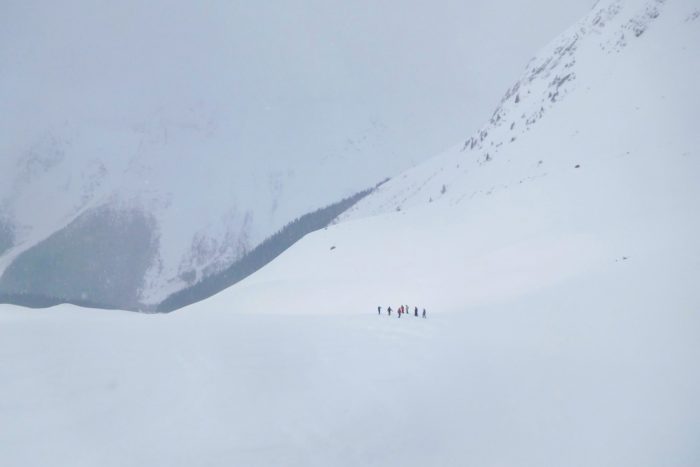
Contrary to the ski porn image in my head, the terrain was relatively mild (as far as I could tell in the flat light). The selection of mild slopes was made due to high avalanche danger and poor visibility.
But every run was a blast — just not as hardcore as I was expecting. Given that my biggest fear going into the experience was dying in an avalanche, I was grateful that the guides were choosing wisely and safely.
Another factor to keep in mind with a group heli-ski trip is you have to cater to every last person’s needs, speed, and occasional yard sale.
After the skiers put down a track through a flattish section above a steep cornice, I followed the other snowboarder, pumping to maintain speed. I gave him plenty of space but saw him fall in the track ahead. I scooped out of the track to avoid him but petered out in the deep snow.
Luckily the guide came to my rescue, using his pole to pull me out of the flats.
To close out the morning, our third heli-ride dropped us atop the aptly named Long Run. It was a slope of dry powder that went on for more than 3,000 vertical feet.
The gentlemen from South America and I had only signed up for three runs. But we eagerly agreed to continue for two more (a mere 95 Canadian dollars each). One of which would take us to our lunch spot.
Run number four was the only run of the day on a lower elevation panel of the Purcells. The slope is called Rosies. With more pitch and thicker snow, it took us into the glades, where the trees brought better visibility than we’d had all day.
As we spread out and slalomed through the glades, one of the instructors screamed at us that we had drifted beyond the boundaries he had described. This reminded me that we were in an unpredictable, high-risk environment, and although jolted by the scolding, I dove into my next powder pillows with more relish.
Finding a pee spot at the lunch break — meandering away from the group beyond the helicopter and swimming through powder to find a little privacy — was the most physically exhausting part of the day. I hadn’t realized how hungry I was until I was diving into a gourmet veggie wrap, standing next to the silent helicopter with a cup of hot tea.
Much like my standard smashed PB&J on a powder day, it felt like one of the best meals of my life.
Not long after, we swooped off in the helicopter again, for the final drop of the day under Jumbo Mountain. Making S-turns down the vast gulley, powder blowing into my chest, I was already thinking about my next heli-adventure.
Heli-Ski in British Columbia: The Last Spin
With a fresh buffet of nachos, wings, and beer awaiting at the heli-plex, our final aerial leg of the day swept over the comparatively refined slopes of Panorama. Toy-sized skiers stopped midslope to cover their eyes and look up.
As I watched them watch us, I soaked up their envy, knowing some were surely fantasizing about their own boundless powder adventure, flying inside the bird to slopes untouched.

